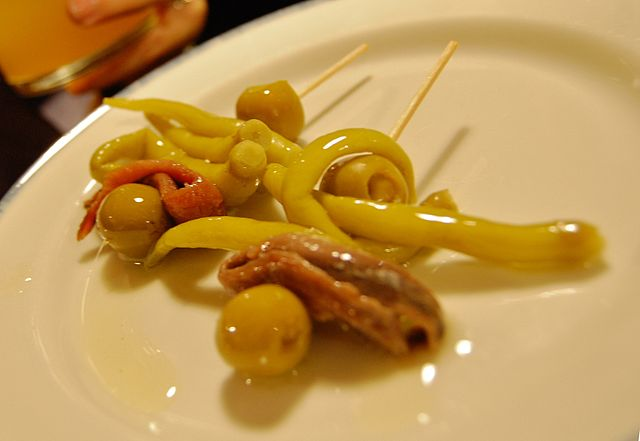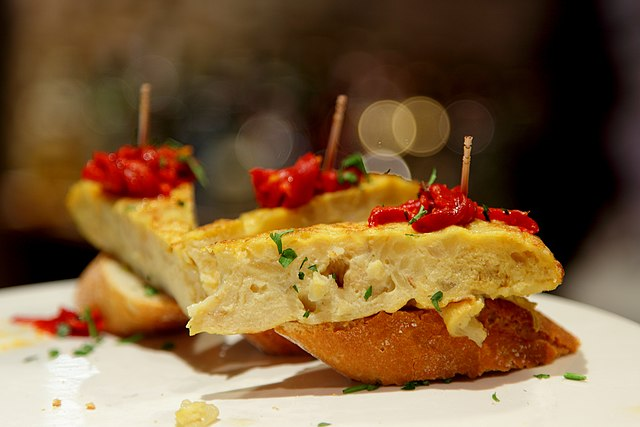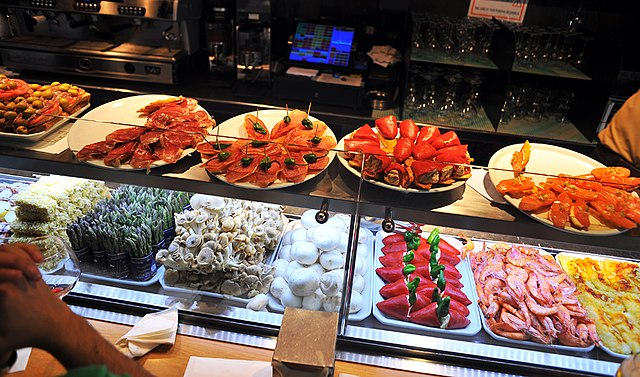Ida: The Tapas Takeover as Influenced by Spain
By Jena Nassar, study abroad student traveling to Spain with Professor Bailly.
Spanish cuisine is just one of the many unique and alluring parts of Spanish culture. Characterized by its Mediterranean elements, much of what Spaniards consume consists of an indulgent variety of ingredients and are utilized in numerous cultural dishes. However, what sets Spanish cuisine apart the most are a simple, small dish found in nearly every bar and restaurant– Tapas!
Tapas are a traditional Spanish bar food usually served alongside beer or wine. The iconic snack comes in a wide variety of options, varying greatly from region to region, and are usually included in the price of the drink. Still, because this custom varies from city to city– the tapas experience may differ in Barcelona than in Madrid, than in Granada, and so on. Yet what stands true is that the custom of eating tapas is a beloved part of Spanish culture and the tradition is now replicated with a regional twist in bars and restaurants all over the world.
HISTORY OF TAPAS
There are multiple known accounts for the origins of traditional tapas. One popular version of its emergence references barkeepers who would cover customer’s drinks with a slice of bread and small piece of cheese and ham. This was done as a way of preventing flies and dust from entering the glass. (Zima) When analyzing the meaning of the word itself, the references to this origin telling are unmistakable. The word tapa comes from the word taper, which means “to cover.’ Similarly, tapa is also the Spanish word for lid. Accordingly, the tapas really did function as a lid to the drinks.(Jessop) Another probable origin story links back to the farmers and fishermen who would stay energized throughout the work day by eating small portions of food. Large meals would tire them out, calling for a few hour siesta.

A different, but perhaps the most widely accepted account claims tapas were first introduced in the 13th century in southern Spain, in the province of Andalucia. (Zima) Its inception came as the Spanish King Alfonoso the 10th of Castile fell ill and was prescribed large quantities of wine as he recovered. To diminish the effects of the alcohol, the king would only take small bites of his food alongside his drink. (Jessop) Following the king’s recovery, he insisted that no wine shall be served in any household unless they are served alongside something to eat, thus preventing public drunkenness.
As stated previously, the tapas experience can vary depending on the region in Spain. In cities like Granada, Jaén, and Almería, the snacks are served in bars, free alongside ordered drinks. The theory is that by offering salty, courtesy tapas to bar-goers, it will encourage them to order more drinks to quench their thirst. In other areas, particularly the more touristy ones, complimentary tapas are sometimes not the norm, but they can still be ordered off the menu for a price. In places like San Sebastián, tapas are actually called pinxtos, and have to be ordered off the menu as they are more gourmet.
TRADITIONAL TAPAS
Now the question is, what constitutes a tapa? It is important to note that size is a large indicator of whether or not a food is a tapa. They are usually very small portions of food and are in their own category– not to be confused with appetizers. There are also a wide assortment of tapas, both hot and cold. Classic assortments consist of tortilla de patatas or jamón serrano, while more exotic options could be snails, known as caracoles. Whatever the preferences may be, there is a tapa for everyone and every taste. As the way tapas are prepared are certainly regionally dependent, below is a collection of the most common throughout Spain and in specific cities.
Gilda

Gildas, found throughout Spain, are salty and pickled peppers, olives, and anchovies bunched onto a skewer. While they can be served alone, they can also be served atop a small piece of bread, in which case it would be called a pincho rather than a tapa. (Lesiuk)
Manchego Cheese

Manchego cheese is a tapa common in Castilla La Mancha. With its complex flavor, it can be eaten on its own or topped with tomatoes, olives, or a drizzling of extra virgin olive oil. (Lesiuk)
Chipirones a la Andaluza

Chipirones a la Andaluza, regional to Andalucia, are miniature squid that have been lightly breaded and fried in olive oil. They are then seasoned with light lemon and salt. (Lesiuk)
Boquerones en vinagre

Found all across Spain, Boquerones en vinagre are one of the most traditional tapas in Spain and are a Spaniard favorite. They are anchovies which have been marinated in vinegar, garlic, and oil. (Lesiuk)
Tortilla Española

Tortilla Española, also known as tortilla de patatas, is often referred to as Spain’s national dish. The tapa is essentially a Spanish omelet, with eggs, onions, salt, pepper, and olive oil. Regional variations exist, such as incorporating red pepper or scallions. The tortilla is often served in small wedges as an easy finger food. (Lesiuk)
Pan con Tomate

Pan con tomate is popular throughout all of Spain but has its origins in Cataluña. It is a tapa that consists of bread topped with a garlic, tomato, and olive oil spread. (Lesiuk)
THE GLOBALIZATION OF TAPAS
Starting off as just an assortment of snacks to accompany bar beverages, tapas have evolved to now become an iconic aspect of Spanish cuisine and culture. It is a customary part of Spaniard living to “bar hop” to multiple restaurants and diners for tapas, referred to as ir de tapas, an effective way of socializing. Consuming an entire meal of tapas is referred to as tapear, and often replaces formal lunch or dinner meals.
Since its inception, tapas have now entered a golden age which has not yet come to an end. The first tapas, presumably those of King Alfonso the 10th, consisted mainly of sliced ham and cheese. Today, the custom of eating Spanish tapas has made its way across the globe, and has evolved to become more exquisite and adapted to multiple local regions in the process. New York in particular has seen an onslaught of tapas bars rising in popularity, each exhibiting their own unique twist on the traditional Spanish snack. ”We can’t help being innovative and adapting things so they work for us,” says Stan Frankenthaler, the owner of Red Herring, a wine and tapas bar in Boston. The bar serves tapas reinvented with an asian-style influence. (Fabricant) In the hands of American chefs, tapas have evolved to become an art form and a social affair in elite restaurants.
Helena Carratala, the owner of Spanish restaurant, Helena’s, is in the heart of New York and specializes in the art of tapas. ”It started 200 years ago among workmen and fishermen, and gradually the elite discovered it, so tapas became fashionable. But it’s cultural and social to stand around with friends gossiping, talking politics, drinking and sharing small plates of food,” says Helena. (Fabricant) Another New York tapas bar in Greenwich Village offers a slightly different tapas experience. Offering a menu of American tapas, diners can enjoy stewed lamb with sweet-potato cakes and hazelnut oil, or they can indulge in a giant soft-shell crab tacos with avocado, tomato salsa and lime cream. “We have Americanized the Spanish concept. Our portions are larger and we’re doing more creative things,” says Tapestry owner, Dan Mendel. (Fabricant) In his restaurant, some diners will eat at the bar, similar to the casual tapa-eating custom in Spain. However, most Tapestry diners tend to eat at tables in the dining room. (Fabricant) This is partly due to the differing portion size of Americanized tapas compared to Spanish tapas. (Knowlton) American tapas usually require a fork and a knife, whereas Spanish tapas are often enjoyed as finger foods or eaten with a toothpick.
The catalyst for much of this global Spanish tapas-takeover can be credited to the Michelin-starred restaurant, El Bulli. Its head chef, Ferran Adrià, experimented with Spanish concepts and flavors to deliver them in a new and unexpected form. (Calvino) The restaurant gathered 2 million diners seeking reservations each season, and only 8,000 were fortunate to claim their spot on the list. However, the reservation came at a price– €250 per plate. (Calvino) While El Bulli revolutionized Spanish cuisine and made it famous globally, the restaurant did not last. It closed in 2012, but had a heavy impact on launching the Spanish restaurant scene found all over the country.
COMPARED TO THE AMERICAS
Having been born out of a practical need– to stop flies from entering drinks, to limit the effects of alcohol, or whichever origin story one chooses to buy into– tapas have grown into a Spanish cuisine staple, and then into an entire food category on the global scale. The influence of Spanish cuisine is widespread and evident in the Americas, with Spanish restaurants and tapas bars popular in cities all over the country. There are however some cultural differences. It is common for Spaniards to make a night out of sampling tapas, moving from one bar to another. Yet in America, this is not the ordinary– people do not usually “go for tapas” in that fashion. Rather, many American tapas bars are sit-down restaurants. And even bars who are not necessarily “sit-down” do not usually have customers hopping from place to place solely for the tapas. Also, Spanish tapas are characterized by their bite-size portions. Whereas in America, these portions are sometimes slightly larger. Thus, they don’t call for ir de tapas.

It is also interesting to note that Spain is not the only home to snack-size, pre-meal dishes. In the Middle East, they have a similar custom in which small portions of a dish are served before the meal. These would usually include pita bread, olives, and hummus, but rather than being called tapas, are known as mezze.
Despite the few differences between American and Spanish tapas, it is undeniable that reinvented bar food in America has been influenced by Spain. Many accounts from restaurant and bar owners have attested to this influence, explaining that they incorporate Spanish cuisines with local flavors and customs. There are some who look down upon this Spanish integration into American culture due to it involving an evolution of traditional aspects of Spanish cuisine. However, I feel that it is rather a form of flattery. Spanish cuisine has brought social diversity and unique flavor to the American palate, allowing one to, quite literally, experience a taste of a distant country.
The various Spanish restaurants I have had the pleasure of dining in have offered sliced breads with a delicious assortment of toppings. Without knowing specifically that these were actually Spanish tapas, it’s easy to overlook them as merely appetizers. Now having evaluated the origins and evolution of Spanish tapas, and comparing it with my own dining experiences here in America, I cannot wait to experience authentic, traditional tapas in Spain this summer!
Citations
Calvino, Erik. “America’s Best Tapas – Travel – Food.” CigarSnob, 14 Jan. 2021, https://www.cigarsnobmag.com/stories/2020/03/04/americas-best-tapas/.
Fabricant, Florence. “Putting the World on a Little Plate.” The New York Times, The New York Times, 16 July 1997, https://www.nytimes.com/1997/07/16/garden/putting-the-world-on-a-little-plate.html.
Jessop, Tara. “A Brief History of the World Famous Spanish Tapas.” Culture Trip, The Culture Trip, 27 Apr. 2016, https://theculturetrip.com/europe/spain/articles/a-brief-history-of-the-world-famous-spanish-tapas/.
Knowlton, Andrew. “Tapas in the U.S.” Bon Appetit, https://www.bonappetit.com/columns/the-foodist/article/tapas-in-the-u-s.
Lesiuk, Tanya. “Top 21 Spanish Tapas (Today’s Tapas Culture): Dotravelmag.” DoTravel Magazine, https://dotravel.com/magazine/article/65/21-traditional-spanish-tapas.
Zima, Sierra. “What Are Spanish Tapas and Where Did They Come from?” Citylife Madrid, 24 Sept. 2021, https://www.citylifemadrid.com/what-are-spanish-tapas/.